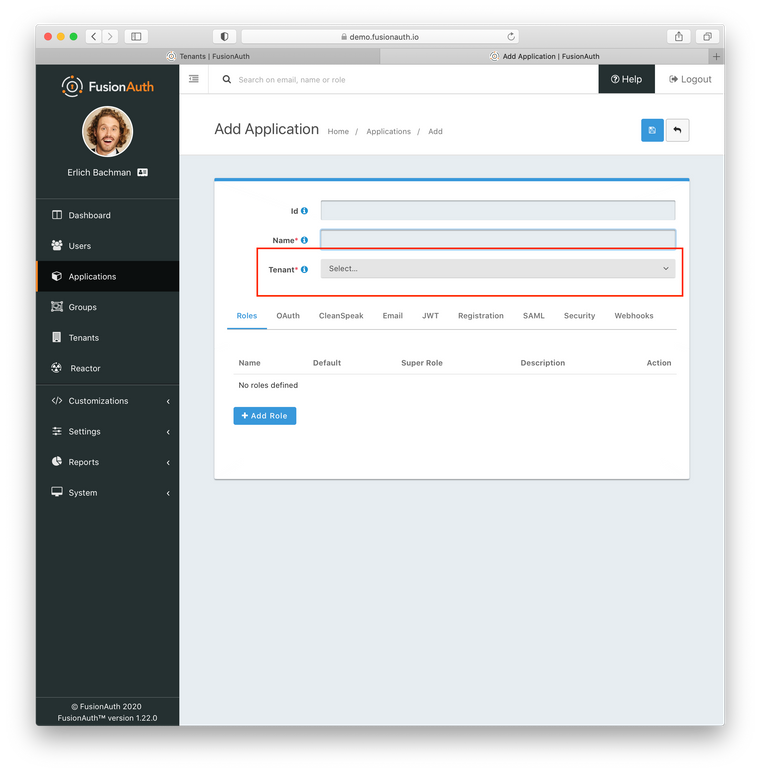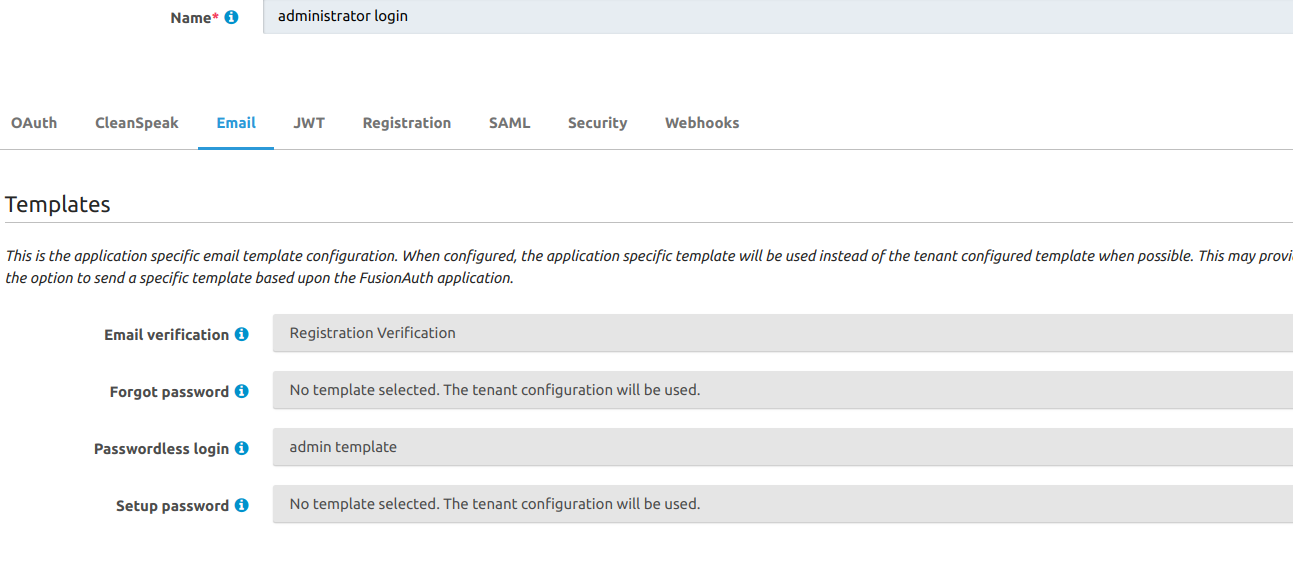workflow for self registration
-
But how to create it under it's own tenant (in the UI)?
Once you have more than one tenant, you should see a dropdown when you are adding an application in the UI which lets you determine which tenant the application is associated with.

Note that tenants have different user email spaces. That is to say that if I have an account with tenant A and an account with tenant B, they might have different passwords and they will certainly have different user attributes (last login, for example). That may be ok, but just wanted to make you aware. You may want to read the tenants core concepts docs if you haven't already.
-
If you have mor than one tenant defined (as you have) then tenant selection dropdown appears in the application creation view. Create chosen application in the second tenant and discard it in the first one.
-
@mgetka jinx!

-
After carefully comparing the passwordless login that worked with the passwordless that didn't work, I can see that the TenantId on the one that didn't work is incorrect. For some reason FA is trying to use the same tenant ID in both cases. They should be two different tenant IDs. BTW, I am using a different tenant for the registration than for the login. Perhaps this is why when the user tries to login, the wrong tenantID is chosen?
So I guess I will need to :Making an API request using a Tenant Id. I am using Codeigniter so I tried using this $this->output->set_header('X-FusionAuth-TenantId: 8ea1c784-866b-4755-b97b-b4fda2ad19e4'); right before my call to start PasswordlessLogin()
The result I am getting is :
FusionAuth\ClientResponse Object
(
[errorResponse] =>
[exception] =>
[method] => POST
[request] => {"applicationId":"2cf00c29-ac46-49bf-8cd4-32538ddb00d8","loginId":"richardbernstein217@gmail.com","state":{"redirect_uri":"http://substantiator-survey.ngrok.io/index.php/Configure/report_generator_amazing","client_id":"2cf00c29-ac46-49bf-8cd4-32538ddb00d8","response_type":"code","scope":"openid","state":"richardbernstein217@gmail.com"}}
[successResponse] =>
[status] => 404
)Obviously not optimum. But I see I can set an API key:
Using an API key.You may optionally create an API key that is scoped to a particular tenant. To create an API key navigate to Settings API Keys.
Similar to the example screenshot above where we created a new API key, in this example we have selected the Pied Piper tenant for this API key. Only Users, Groups and Applications belonging to the Pied Piper tenant will be visible to this API.
Create a Tenant API Key
HTTP Authorization Header example
The following example demonstrates an API request to an API endpoint requiring tenantId, using the tenant-scoped API key.curl -X POST
-H 'Authorization: oa06-d9uxCHTorBOkVdh_QzsX_iEEYARGv8udnMMLJ8'
-H 'Content-Type: application/json'
-d '{"group": {"name": "Admin"}}'
"http://localhost:9011/api/group"Setting this up requires me to choose an endpoint with Get, put, patch, post, delete. I have no idea how to get my tenant id, 8ea1c784-866b-4755-b97b-b4fda2ad19e4, to work with my call to startPasswordlessLogin. Is there an example anywhere?
-
Some posts ago you have mentioned that both of your apps reside in the same tenant. Moving one of them into another tenant was mentioned but I suppose you have abandoned the idea in the meantime. So, if they are both in same tenant, why would you expect FA to use different tenant ID for each app?
BTW,
$this->output->set_headersets the header for a response sent to the web browser - data defined this way will never reach FA. -
No you are correct, they are in different tenants. That is why I need to set the "header info" as per the docs.
The docs say that if you have more than one tenant, which I do, that you will need to specify the tenant via the "header". There is even an example: HTTP Authorization Header example
curl -X POST
-H 'Authorization: oa06-d9uxCHTorBOkVdh_QzsX_iEEYARGv8udnMMLJ8'
-H 'Content-Type: application/json'
-d '{"group": {"name": "Admin"}}'
"http://localhost:9011/api/group"But that example makes no sense to someone using the php client.
Please tell me how to tell FA the tenant to use in the context of a php program?
-
Referring to the PHP client source code, the tenant id can be set for the client using
withTenantIdmethod. Something like this should work:$client->withTenantId(...)->passwordlessLogin(...);Be aware that
withTenantIdstores the id in the client internal state, and the stored id will be used for all subsequent requests. It may be something that suits you or not - refer to the source code and check how this effect will affect your application. -
@mgetka Thanks. I found this:
public function withTenantId($tenantId) {
$this->tenantId = $tenantId;
return $this;
}/**
- Takes an action on a user. The user being actioned is called the "actionee" and the user taking the action is called the
- "actioner". Both user ids are required in the request object.
- @param array $request The action request that includes all of the information about the action being taken including
-
the id of the action, any options and the duration (if applicable).
What two users are they talking about? There is only one user involved. Does this make sense?
$requestJ = json_encode($request); //convert the array into json $result = $_SESSION['client']->setTenantId('8ea1c784-866b-4755-b97b-b4fda2ad19e4')->startPasswordlesslogin($requestJ); -
The quoted code comment refers to
actionUserAPI method, not thewitheTenantIdclient method. -
This post is deleted! -
@mgetka Is there any example of how to specify a tenantID in a php call? I searched for ->withTenantId() as you show in your example call above and can't find it anywhere on the FA site.
-
The code snippet I put in the post where I first mention the
withTenantIdmethod is actually such an example. When I recommended referencing the source code, I meant the code itself, not the docstrings - the logic behind thewithTenantIdmethod is quite simple, and the code describes mentioned effects (alteration of internal client state) in the most unambigious way.If you need more verbose examples see the code below
<?php require __DIR__ . '/vendor/autoload.php'; $apiKey = "5a826da2-1e3a-49df-85ba-cd88575e4e9d"; $client = new FusionAuth\FusionAuthClient($apiKey, "http://localhost:9011"); $request = array( "applicationId" => "c9a6f176-93df-4eaa-b67c-b651d18df60c", "loginId" => "user" ); $result = $client->withTenantId("adca656e-4895-4a9e-ac2e-8b9ebebb5149")->startPasswordlesslogin($request); var_dump($result); ?>For such a call, the client invokes following HTTP API request
POST /api/passwordless/start HTTP/1.1 Host: [...]:9011 Accept: */* X-FusionAuth-TenantId: adca656e-4895-4a9e-ac2e-8b9ebebb5149 Authorization: 5a826da2-1e3a-49df-85ba-cd88575e4e9d Content-Length: 73 Content-Type: application/json {"applicationId":"c9a6f176-93df-4eaa-b67c-b651d18df60c","loginId":"user"} -
Thanks. I modified as requested. I am still getting a 404 error. Note that the errorResponse is blank.
Here is the call:
$result = $_SESSION['client']->withTenantId('8ea1c784-866b-4755-b97b-b4fda2ad19e4')->startPasswordlesslogin($requestJ);Here is the $result I am seeing:
FusionAuth\ClientResponse Object
(
[errorResponse] =>
[exception] =>
[method] => POST
[request] => {"applicationId":"2cf00c29-ac46-49bf-8cd4-32538ddb00d8","loginId":"richardbernstein217@gmail.com","state":{"redirect_uri":"http://substantiator-survey.ngrok.io/index.php/Configure/report_generator_amazing","client_id":"2cf00c29-ac46-49bf-8cd4-32538ddb00d8","response_type":"code","scope":"openid","state":"richardbernstein217@gmail.com"}}
[successResponse] =>
[status] => 404
) -
This is a valid result with clear cause described in the docs.
404
The user was not found. The response will be empty.You need to understand that each tenant has its own, separate user base. So, if the user exists in one tenant, he doesn't necessarily exists in another. Anticipating your question, you cannot have a common user base for multiple tenants - If you want to have single user base, then work on a single tenant.
-
OK. I switched over to doing both the user registration and the user passwordless login in a single tenant. In this tenant, I need to set both the registration verify template and the passwordless login template. I am not sure where to set the reg verify template. Hre is an image of what I have set:

I don't see a place for the verify registration template?
When a user tries to register, I get a "530 Authentication required" error in the event log, and the verify email is not being sent.
-
Passwordless template is used for passwordless email, so as you are using passwordless login flow, you need this template. This topic, started with the question about email verification, so I suppose you use this feature, and email verification template will be useful as well. As for the registration verification template, as I have recently written:
To sum it up, user entity, created on an user creation event represents an user. This entity contains the user email and its verification status. The user email verification email may be sent only on user creation.
The registration, is an entity that associates already existing user to a specific application. The registration is not related to user email nor its verification status. However, it can contain alternative username to be used by the user in this application only. On an event of registration creation, FA can send confirmation email, but it doesn't confirm user email, it only confirms whether the registration of an user in the application should persist.So if you want users to confirm registrations in certain applications (in addition to verifying email addresses, which can be understood as account creation verification), configure the functionality, and prepare registration verification template.
530 Authentication requiredSMTP error means that your tenant SMTP configuration is invalid. -
@mgetka Thanks. I will try it.
Here is the current way I try to add a user and register them.$request = array();
$request["registration"]["applicationId"] = $_SESSION['applicationID_admin_register_login'];
$request["user"]["email"] = $email;
$request["user"]["password"] = "12345678";
$request["user"]["userId"] = $id; //this is the record number from the employees table -needed to delete the record from mySQL
$request["user"]["type"] = "admin"; //mark this guy as admin
//add the id from the employees table
$requestJ = json_encode($request); //convert the array into json
$result = $_SESSION['client']->register("", $requestJ);Are you saying that I need to set the registration verifcation emaIl via the API, rather than using the UI (see the email verification text field in above image)? Notice that I am not using the tenantID anywhere in this? But the application ID is used and it does have a tenant associated with it. Again, just to make my question clear. Where do I specify in the UI which template to run for registration verification?
On the tenant SMTP and the 503 error, I am using the EXACT same SMTP that was working correctly before I moved to a new application (due to not being able to do the registration in one tenant and the login in a different one).
-
$request["user"]["type"] = "admin";The user entity has not
typemember. To make such a distinction you can use groups.You can set registration verification template either via GUI ora API - it doesn't make a difference. Since registrations are application specific, you firstly need to enable application's registrations verification and then you can select the template. Via GUI it can be done in Edit Application > Registration.
But still, at the moment I'm rather confused, and don't really know what are you actually trying to achieve. I suppose that email verification is the only verification that you need, but that is just my guesing.
In the previos post you mentioned 530 error, now it is 503. Also, you haven't provided full trace, so my response was based on some guessing, and the fact that 530 is actually defined in SMTP. On the other hand 503 HTTP code may be returned by the FA on an event of elastic search issues.
503
The search index is not available or encountered an exception so the request cannot be completed. The response will contain a JSON body. -
@mgetka It is 530. When I try to send a test email from this application I get
"Unable to send email via JavaMail530 Authentication required"
Is that something that can be fixed in my FA setup or is this a question for AWS? I do have another application using the same smtp that works fine.
-
Email troubleshooting is documented here: https://fusionauth.io/docs/v1/tech/troubleshooting/#troubleshooting-email
Might be worth trying some of the steps outlined there.